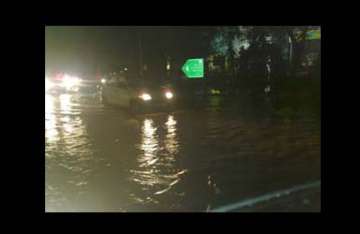New Delhi: At least 11 people dead, traffic snarls lasting up to 5 hours, roads submerged in knee-deep water with traffic lights on the blink in key intersections, hundreds of fallen trees and rainwater inside homes — three hours of rain is all it took to expose the chinks in Delhi's infrastructure ahead of the Commonwealth Games.
From 5.30pm to 8.30pm, the city recorded 51.4mm rainfall and wind with speed ranging between 82-90 kmph. Till evening, only parts of the city had reported brief showers and humidity levels were at an uncomfortable 80%. But by 6pm, the situation changed completely. A sudden downpour began in central Delhi and spread to east, south and north Delhi.
As water collected on several arterial roads, nightmarish traffic jams were reported from almost all major roads in the city. The rain caught people returning home from work in the evening rush hour and commuters spent up to five hours on the roads as the traffic police and civic agencies made desperate attempts to clear out rain water and fallen trees and create room for vehicles.
The worst jams were reported from ITO bridge, IP flyover, Laxmi Nagar Chungi, ITO, Tilak Marg, India Gate, Azadpur Railway underpass, GPO roundabout, Ashoka Road, Kashmere Gate, BRT corridor, Ashram, Ring Road, Outer Ring Road and Yamuna Bank Metro station. Traffic signals also went on the blink in several key intersections. Widespread construction activity before the Commonwealth Games aggravated the situation as roads caved in and cars got stuck in loose soil in several areas.
6 persons were killed by electrocution — 2 each at Chandni Chowk , Mansarovar Park and West Patel Nagar, respectively. 5 people died in wall collapses — 2 at Vivek Vihar, 3 at Jhilmil Colony. 8 persons were injured in wall collapses at Jamia Nagar and Pandav Nagar.
Rain water also entered homes in Patel Nagar, Pusa Road, Rajinder Nagar, Jangpura and Greater Kailash-I. In several areas, large trees and branches were brought down by heavy winds. Officials said many of the trees were old but also large scale streetscaping work had left the roots of large trees exposed, making them vulnerable in the heavy storm.
Latest India News
